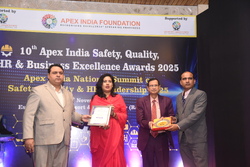IPCC Meeting In Hangzhou, China On Carbon Removal Technologies
CCUS is expected to play a key role in limiting global temperature rise to 1.5°C

The Intergovernmental Panel on Climate Change (IPCC) will be meeting in Hangzhou, China, from 24 to 28 February 2025 to agree on the outlines of the three Working Group contributions to the Seventh Assessment Report (AR7) and the Methodology Report on Carbon Dioxide Removal Technologies, Carbon Capture Utilization and Storage.
Different options to try to reduce overall CO2 emissions are being investigated, but the main way to reduce CO2 emissions from large industrial sources is called carbon capture and storage, or CCS. CCS involves capturing carbon dioxide (CO2) at emission sources, transporting and then storing or burying it in a suitable deep, underground location. CCS can also mean the removal of CO2 directly or indirectly from the atmosphere.
How CCUS works
- Capture: CO2 is separated from other gases at the source.
- Transport: Compressed CO2 is transported to a storage site by pipeline, ship, rail, or truck.
- Store: CO2 is injected into deep geological formations like depleted oil and gas reservoirs or saline aquifers.
- Use: CO2 can be used to create chemicals, liquid fuels, and polymers.
Why CCUS is important
CCUS is expected to play a key role in limiting global temperature rise to 1.5°C. The Intergovernmental Panel on Climate Change (IPCC) says that carbon dioxide removal (CDR) technologies are necessary to achieve net zero CO2 emissions.
Other carbon dioxide removal technologies
Carbon dioxide removal (CDR) technologies remove CO2 from the atmosphere, lowering its concentration.
CCUS deployment has been behind expectations in the past but momentum has grown substantially in recent years, with over 700 projects in various stages of development across the CCUS value chain.
Around 45 commercial facilities are already in operation applying carbon capture, utilisation and storage (CCUS) to industrial processes, fuel transformation and power generation. CCUS deployment has trailed behind expectations in the past, but momentum has grown substantially in recent years, with over 700 projects in various stages of development across the CCUS value chain. In 2023, announced capture capacity for 2030 increased by 35%, while announced storage capacity rose by 70%. This brings the total amount of CO2 that could be captured in 2030 to around 435 million tonnes (Mt) per year and announced storage capacity to around 615 Mt of CO2 per year. While this momentum from announcements is positive, it still just around 40% (and 60%, respectively) of the circa 1 Gt CO2 per year which is captured and stored in the Net Zero Emissions by 2050 (NZE) Scenario. Nevertheless, even at such level, CCUS deployment would remain well below what is required in the Net Zero Scenario.
During the IPCC’s 62nd Plenary Session hosted by the People’s Republic of China, the Panel will consider the draft outlines of the three Working Group contributions to the Seventh Assessment Report and the draft outline of the Methodology Report on Carbon Dioxide Removal Technologies, Carbon Capture Utilization and Storage, and the respective timelines and budgets for these reports. In addition, government delegates of the 195-member country Panel will be updated on the broad draft outline of the AR7 Synthesis Report.
The writer of this article is Dr. Seema Javed, an environmentalist & a communications professional in the field of climate and energy




